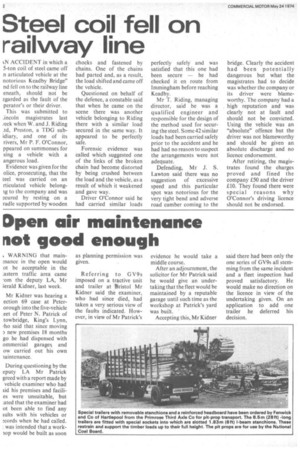Steel coil fell on railway line
Page 24

If you've noticed an error in this article please click here to report it so we can fix it.
N ACCIDENT in which a 5-ton coil of steel came off n articulated vehicle at the notorious Keadby Bridge" nd fell on to the railway line eneath, should not be egarded as the fault of the perator's or their driver. This was submitted to ,incoln magistrates last ,,eek when W. and J. Riding ,td, Preston, a TDG sub[diary, and one of its rivers, Mr P. F. O'Connor, ppeared on summonses for sing a vehicle with a angerous load.
Evidence was given for the olice, prosecuting, that the tee was carried on an rticulated vehicle belongto the company and was ecured by resting on a radlc supported by wooden chocks and fastened by chains. One of the chains had parted and, as a result, the load shifted and came off the vehicle.
Questioned on behalf of the defence, a constable said that when he came on the scene there was another vehicle belonging to Riding there with a similar load secured in the same way. It appeared to be perfectly safe.
Forensic evidence was called which suggested one of the links of the broken chain had become distorted by being crushed between the load and the vehicle, as a result of which it weakened and gave way.
Driver O'Connor said he had carried similar loads perfectly safely and was satisfied that this one had been secure — he had checked it en route from Immingham before reaching Keaclby.
Mr T. Riding, managing director, said he was a qualified engineer and responsible for the design of the method used for securing the steel. Some 42 similar loads had been carried safely prior to the accident and he had had no reason to suspect the arrangements were not adequate.
Defending, Mr J. S. Lawton said there was no suggestion of excessive speed and this particular spot was notorious for the very tight bend and adverse road camber coming to the bridge. Clearly the accident had been potentially dangerous but what the magistrates had to decide was whether the company or its driver were blameworthy. The companyhad a high reputation and was clearly not at fault and should not be convicted. Using the vehicle was an "absolute" offence but the driver was not blameworthy and should be given an absolute discharge and no licence endorsement.
After retiring, the magistrates found the charges proved and fined the company £50 and the driver £10. They found there were special reasons why O'Connor's driving licence should not be endorsed.




































































































































